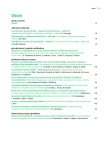Present and future in the management of venous vascular diseases
Authors:
Peter Gavorník 1,2,3; Andrej Dukát 1,3; Ľudovít Gašpar 1,3; Eva Gavorníková 4
Authors‘ workplace:
II. interná klinika LF UK a UN Bratislava, Slovenská republika, prednosta doc. MUDr. Ľudovít Gašpar, CSc.
1; Prvé angiologické pracovisko (PAP), vedúci lekár doc. MUDr. Peter Gavorník, PhD., mim. prof.
2; Sekcia angiológov Slovenskej lekárskej komory, predseda doc. MUDr. Peter Gavorník, PhD., mim. prof.
3; Ambulancia všeobecného lekára pre dospelých, Poliklinika Ružinov, Bratislava, Slovenská republika
4
Published in:
Vnitř Lék 2015; 61(2): 151-156
Category:
Guidelines
Overview
The prevalence and the incidence of chronic and acute venous vascular disease has been shown to be globally very high, in both industrialized and developing countries. Chronic venous diseases of lower extremities are being an integral part of the third millennium´s deadly angiopandemy, at the present time. The rate of the most severe cases with advanced stage of venous failure is approximately twice as high in the population (2.1 %) as has been assumed so far. Among venoactive drugs (VAD), micronized purified flavonoid fraction (MPFF) of diosmin hesperidin remains the agent with the highest degree of recommendation and it also indicated to pharmacotherapeutical support of leg ulcer healing, along with sulodexide and pentoxifylline. Compressive sclerotherapy, liquid or foam, is a safe and effective invasive method to treat telangiectasias, reticular varicose veins and subcutaneous varicose veins. Direct oral anticoagulants (DOAC) represent one of the therapeutic and preventive options of deep venous thrombosis (DVT) and of venous thromboembolism (VTE) with a limitation in patients with malignant conditions and in pregnancy. The most effective is triple simultaneous pharmaco-kinezio-mechano-phlebothromboemboloprophylaxis. Superficial vein thromboses longer than 5 cm are indicated to anticoagulant therapy too.
Key words:
angiology/vascular medicine – future – management – phlebology/venous medicine – present – vein – venous vascular disease
Sources
1. Management of chronic venous disorders of the lower limbs. Guidelines according to scientific evidence. Int Angiol 2014; 33(2): 87–208.
2. Zdravotnícka ročenka Slovenskej republiky 2012. Národné centrum zdravotníckych informácií: Bratislava 2014. ISBN 978–80–89292–34–9.
3. Rabe E, Guex JJ, Puskas A et al. VCP Coordinators. Epidemiology of chronic venous disorders in geographically diverse populations: results from the Vein Consult Program. Int Angiol 2012; 31(2): 105–115.
4. Gavorník P. Najčastejšie choroby vénového cievneho systému. Univerzita Komenského v Bratislave: Bratislava 2014. ISBN 978–80–223–3453–2.
5. Partsch H. The role of leg compression in the treatment of deep vein thrombosis. Phlebology 2014; 29(Suppl 1): 66–70.
6. Zimmet SE, Min RJ, Comerota AJ et al. Core content for training in venous and lymphatic medicine. Phlebology 2014; 29(9): 587–593.
7. Partsch H, Lee BB. Phlebology and lymphology – A family affair. Phlebology 2014; 29(10): 645–647.
8. Rabe E, Breu F, Cavezzi A et al. for the guideline group. European guidelines for sclerotherapy in chronic venous disorders. Phlebology 2014; 29(6): 338–354.
9. Gavorník P. Mátyás K. Flebotromboemboloprofylaxia vénovej tromboembólie (VTE) – 3. verzia odporúčaní AS SLK, 2014. Medikom/MediNews 2014; 4(4): 12–14.
10. Gavorník P, Gašpar Ľ, Dukát A. Kombinovaná kinezio-flebotromboemboloprofylaxia, mechano-flebotromboemboloprofylaxia a farmako-flebotromboemboloprofylaxia vénovej tromboembólie v internej medicíne. Vnitř Lék 2012; 58(11): 851–855.
11. MacLean S, Mulla S, Akl E et al. Patient values and preferences in decision making for antithrombotic therapy: a systematic review: Antithrombotic Therapy and Prevention of Thrombosis, 9th ed: American College of Chest Physicians Evidence-Based Clinical Practice Guidelines.Chest 2012; 141(2 Suppl): e1S-e801S. Dostupné z DOI: <http://doi: 10.1378/chest.11–2290>.
12. Nicolaides AN, Fareed J, Kakkar AK et al. Prevention and treatment of venous thromboembolism--International Consensus Statement. Int Angiol 2013; 32(2): 111–260.
13. Michiels JJ, Moosdorff W, Maasland H et al. Duplex ultrasound, clinical score, thrombotic risk, and D-dimer testing for evidence based diagnosis and management of deep vein thrombosis and alternative diagnoses in the primary care setting and outpatient ward. Int Angiol 2014; 33(1): 1–19.
14. Alotabi G, Alsaleh K, Wu C et al. Dabigatran, rivaroxaban and apixaban for extended venous thromboembolism treatment – network meta-analysis. Int Angiol 2014; 33(4): 301–308.
15. Gary T. Cancer related venous thromboembolism – prophylaxis and therapy. Vasa 2014; 43(4): 245–251.
16. Partsch H. Compression therapy for deep vein thrombosis. Vasa 2014; 43(5): 305–307.
17. Hirschl M, Kundi M. New oral anticoagulants in the treatment of acute venous thromboembolism – a systematic review with indirect comparisons. Vasa 2014; 43(5): 353–364.
18. Remková A et al. Žilová trombóza a pľúcna embólia. Samedi: Bratislava 2013. ISBN 978–80–970825–2-9.
19. Konstantinides SV, Torbicki A, Agnelli G et al. 2014 ESC Guidelines on the diagnosis and management of acute pulmonary embolism. The Task Force for the Diagnosis and Management of Acute Pulmonary Embolism of the European Society of Cardiology (ESC). Eur Heart J 2014; 35(43): 3033–3069. Dostupné z DOI: <http//dx.doi.org/10.1093/eurheartj/ehu283>.
20. Gavorník P, Dukát A, Gašpar Ľ. Manažment povrchovej tromboflebitídy. Odporúčania Angiologickej sekcie Slovenskej lekárskej komory (2013). Vnitř Lék 2013; 59(11): 1009–1016.
21. Smilowitz NR, Mega JL, Berger JS. Duration of Anticoagulation for Venous Thromboembolic Events. Circulation 2014; 130(25): 2343–2348.
22. Zakai NA, McClure LA, Judd SE et al. Racial and Regional Differences in Venous Thromboembolism in the United States in 3 Cohorts. Circulation 2014; 129(14):1502–1509.
23. Goldhaber SZ. Race and Venous Thromboembolisms: Nature or Nurture? Circulation 2014; 129(14): 1463–1465.
24. Wadhera RK, Russell CE, Piazza G. Cardiology patient page. Warfarin versus novel oral anticoagulants: how to choose? Circulation 2014; 130(22): e191- e193. Dostupné z DOI: <http://doi: 10.1161/CIRCULATIONAHA.114.010426>.
25. Kahn SR, Comerota AJ, Cushman M et al. American Heart Association Council on Peripheral Vascular Disease, Council on Clinical Cardiology, and Council on Cardiovascular and Stroke Nursing. The Postthrombotic Syndrome: Evidence-Based Prevention, Diagnosis, and Treatment Strategies: A Scientific Statement From the American Heart Association. Circulation 2014; 130(18): 1636–1661.
Labels
Diabetology Endocrinology Internal medicineArticle was published in
Internal Medicine

2015 Issue 2
Most read in this issue
- Spontaneous bacterial peritonitis
- The examination of the small intestine by magnetic resonance imaging
- Empagliflozin – the new representative of SGLT2 transporter inhibitors for the treatment of patients with diabetes 2 type
- The importance of transcutaneous oxygen tension monitoring in diabetic patient with complications
